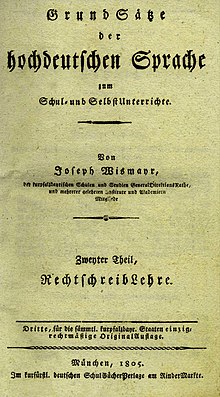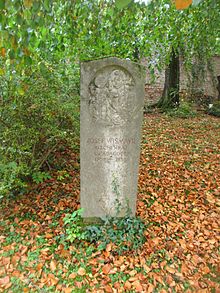Joseph Wismayr
Joseph Wismayr (born November 30, 1767 in Freising , † July 8, 1858 in Munich ) was a Bavarian theologian and educator.
Act
Wismayr was initially prefect of the Lodronic-Rupertine educational institute in Salzburg. In 1803 he was appointed to the Bavarian Ministry of the Interior by Maximilian von Montgelas as a general director of schools and studies, and later also senior church councilor, in order to reorganize the higher education system in a realistic, philanthropic sense. He played a key role in the reforming curricula of 1804. In 1806 he warned: the school must be a 'school of joy' for the children, one must not take away the joy of the children through bad methods. His organizational plan was violently attacked by the humanist party and from 1808 onwards it was redesigned by Friedrich Immanuel Niethammer . The philologist Johann Heinrich Voss was also involved in the disputes over the reforms . Wismayr has written a language and a spelling theory .
tomb
The tomb of Joseph Wismayr is on the old southern cemetery in Munich (Wall Links Course SP 2-23 at cemetery 15) location .
Wismayr's spelling theory

title
The original spelling of the title is based on the principles of the high German language for school and self-teaching. Zweyter Part, Spelling Teaching.
content
- General introduction on the origin and gradual development of written language in general. § 1 - § 10.
- Special introduction or preliminary terms for German spelling theory. § 11 - § 16.
- First chapter. General principles of high German written language. § 17 - § 28.
- Chapter two. Special rules and remarks on the use of German written letters. § 29 - § 38.
- Third chapter. From the expansion and sharpening designation of the German auxiliary sounds. § 39 - § 45.
- Chapter Four. On the division, contraction, abbreviation and composition of German words. Section 46 - Section 52.
- Fifth chapter. About the use of the capital letters in the German written language. Section 52 - Section 54.
- Sixth chapter. Of the distinctive and other orthographic signs. § 55 - § 70.
- Seventh chapter. Individual principles and remarks on the cause of correct spelling in general. § 71 - § 87.
- Appendix or list of the most excellent identical or similar words in the High German language, with examples and comments on how they must be written in each case.
layout
The work is designed as a textbook and for self-teaching. It is intended to enable the student to find out the spelling of a word without digging into scientific fields.
The design is new in several areas: The paragraphs of the first chapter do not have descriptive headings, but each paragraph is headed with a specific question. There are also issues treated like "Is the general writing invariably use?" . In the appendix, which is to be seen as an orthographic dictionary for schools, the words are not simply listed, but each word is given a small example sentence to copy, for example “bee - the bee collects honey” or “steadfast - the man stands where women tremble ” .
Appear
As part of Wismayr's main work, the spelling theory has been published in 9 editions over a period of more than 40 years. There are numerous pirated prints .
Honors and memberships
Wismayr was a knight of the Royal Bavarian Order of Saint Michael and the Grand Ducal Hessian Order of Merit 1st Class, a regular frequenting member of the Royal Bavarian Academy of Sciences in Munich , a regular external member of the academies in Erfurt, Padua, Arezzo and Florence and a corresponding member of the learned society in Jena and the Society for Older German History in Frankfurt.
Works
- Basic principles of the German language for school and self-teaching. Part 1: Linguistics, Part 2: Spelling theory. Salzburg 1796.
- Principles of the High German language for school and self-teaching. Part 1: Linguistics, Part 2: Spelling theory. Munich 1805.
- Textbook of the German language. Munich 1811.
literature
- Hermann Wagner: The Pedagogue Josef Wismayr in Salzburg. Salzburg 1876.
- Friedrich Paulsen: History of the learned teaching. Leipzig 1885.
- Oskar Steinel: The Wismayr curriculum. Wuerzburg 1888.
- Constantin von Wurzbach : Wismayr, Joseph . In: Biographisches Lexikon des Kaiserthums Oesterreich . 57th part. Kaiserlich-Königliche Hof- und Staatsdruckerei, Vienna 1889, pp. 127–130 ( digitized version ).
Web links
- The school reforms by Maximilian von Mongelas and Joseph Wismayr (InternetArchive) ( Memento from April 26, 2006 in the Internet Archive )
Individual evidence
| personal data | |
|---|---|
| SURNAME | Wismayr, Joseph |
| BRIEF DESCRIPTION | German theologian and educator |
| DATE OF BIRTH | November 30, 1767 |
| PLACE OF BIRTH | Freising |
| DATE OF DEATH | July 8, 1858 |
| Place of death | Munich |
